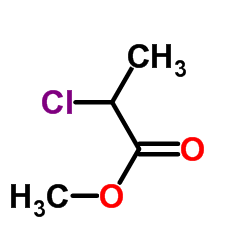UNII:FDN17EXK1J

UNII:FDN17EXK1J structure
|
Common Name | UNII:FDN17EXK1J | ||
|---|---|---|---|---|
| CAS Number | 17639-93-9 | Molecular Weight | 122.550 | |
| Density | 1.1±0.1 g/cm3 | Boiling Point | 130.8±8.0 °C at 760 mmHg | |
| Molecular Formula | C4H7ClO2 | Melting Point | -10 °C | |
| MSDS | Chinese USA | Flash Point | 38.3±0.0 °C | |
| Symbol |


GHS02, GHS07 |
Signal Word | Warning | |
|
Opposite signs of capacitive microsensor signals upon exposure to the enantiomers of methyl propionate compounds.
Angew. Chem. Int. Ed. Engl. 47(5) , 913-6, (2008)
|
|
|
Chiral discrimination of inhalation anesthetics and methyl propionates by thickness shear mode resonators: new insights into the mechanisms of enantioselectivity by cyclodextrins.
Anal. Chem. 69(19) , 4017-31, (1997) The discrimination of the enantiomers of methyl lactate, methyl 2-chloropropionate, and the inhalation anesthetics enflurane, isoflurane, and desflurane in the gas phase has been performed using thickness shear mode resonators. The selective coating was a mod... |
|
|
Regulation of Protein Binding Capability of Surfaces via Host-Guest Interactions: Effects of Localized and Average Ligand Density.
Langmuir 31 , 6172-8, (2015) The protein binding capability of biomaterial surfaces can significantly affect subsequent biological responses, and appropriate ligand presentation is often required to guarantee the best functions. Herein, a new facile method for regulating this capability ... |
|
|
A simple method to determine the enantiomeric ratio in enantioselective biocatalysis.
Enzyme Microb. Technol. 15(12) , 1051-6, (1993) The enantiomeric ratio (E) is commonly used to characterize the enantioselectivity in enzyme-catalyzed kinetic resolution. In this paper this parameter is directly derived from the enantiomeric excess of substrate and product. This is formally more correct th... |
|
|
[The establishment of the MPEL for carboxylic acid derivatives in the air of a work area by using mathematical models].
Gig. Tr. Prof. Zabol. (5) , 36-8, (1992) Reports of MACs for carboxylic acid derivatives as sodium methoxyacetate (SMOA), methyl chlorpropionate (MCP) and acetoacetic ether (AAE). SMOA shows low toxicity, no cumulation and specific action MCP demonstrates moderate toxicity, low cumulation no specifi... |
|
|
Copolymerization of N, N-dimethylacrylamide with n-butyl acrylate via atom transfer radical polymerization. Neugebauer D and Matyjaszewski K.
Macromolecules 36(8) , 2598-2603, (2003)
|
|
|
Thermal response of narrow-disperse poly (N-isopropylacrylamide) prepared by atom transfer radical polymerization. Xia Y, et al.
Macromolecules 38(14) , 5937-5943, (2005)
|
|
|
Controllable synthesis of poly (N-vinylpyrrolidone) and its block copolymers by atom transfer radical polymerization. Lu X, et al.
Polymer 48(10) , 2835-2842, (2007)
|
|
|
Acrylamide Homopolymers and Acrylamide-N-Isopropylacrylamide Block Copolymers by Atomic Transfer Radical Polymerization in Water. Wever DAZ, et al.
Macromolecules 45(10) , 4040-4045, (2012)
|